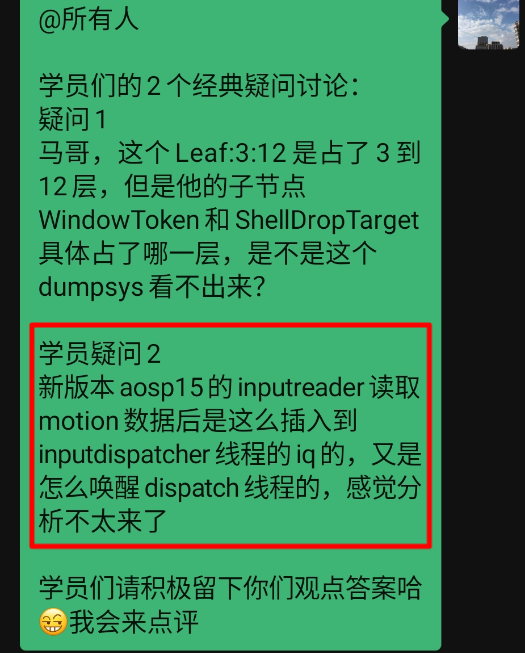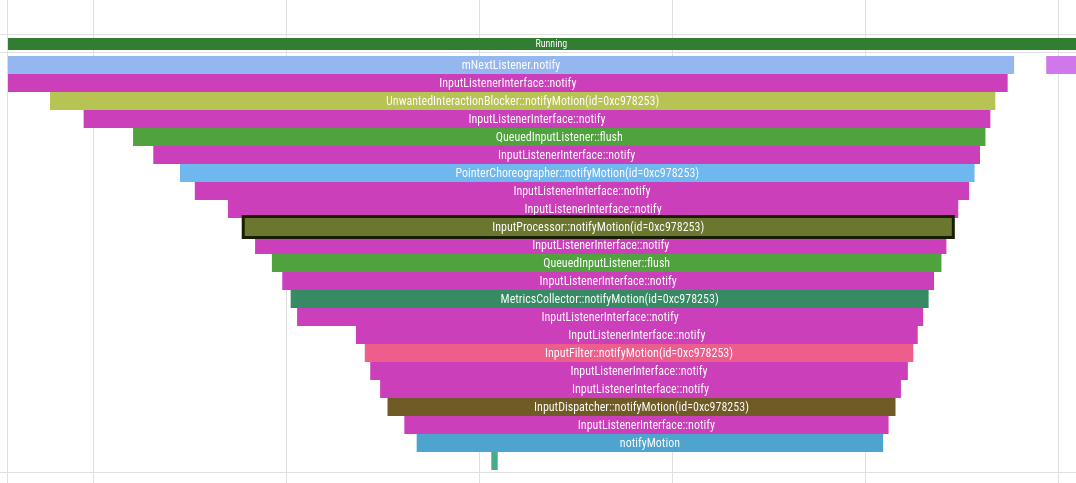背景:
针对学员提出的新版本的事件通知notify部分,InputReader代码到底是如何调用到InputDispatcher的notifyMotion,notifyKey等方法的。

马哥这边看了aosp15的代码后,确实发现这块代码明显比以前绕了比较多,主要加入了多个层次的事件流转,有点雷士以前事件到了ViewRootImpl中要经过多个InputStage进行process,针对这块马哥今天搞一个文章专门来进行解释一下。
InputReader部分源码分析
aosp15版本源码如下
InputReader代码中在整个代码核心流程如下
frameworks/native/services/inputflinger/reader/InputReader.cpp
void InputReader::loopOnce() {
//省略部分不重要
//getEvents获取相关的RawEvent
std::vector<RawEvent> events = mEventHub->getEvents(timeoutMillis);
if (!events.empty()) {
//处理原始RawEvent进行转变NotifyArgs
mPendingArgs += processEventsLocked(events.data(), events.size());
}
//针对NotifyArgs进行notify
for (const NotifyArgs& args : notifyArgs) {
ATRACE_NAME("mNextListener.notify");
mNextListener.notify(args);
}
}
在新版本这里mNextListener.notify(args)具体调用到哪里呢?
mNextListener实际上是InputReader构造时候传递进来的
InputReader::InputReader(std::shared_ptr<EventHubInterface> eventHub,
const sp<InputReaderPolicyInterface>& policy,
InputListenerInterface& listener)
: mContext(this),
mEventHub(eventHub),
mPolicy(policy),
mNextListener(listener),
构造InputReader是在createInputReader进行构造的:
frameworks/native/services/inputflinger/reader/InputReaderFactory.cpp
//第二个参数就是给上面的mNextListener赋值的
std::unique_ptr<InputReaderInterface> createInputReader(
const sp<InputReaderPolicyInterface>& policy, InputListenerInterface& listener) {
return std::make_unique<InputReader>(std::make_unique<EventHub>(), policy, listener);
}
那么什么时候调用的createInputReader呢?
frameworks/native/services/inputflinger/InputManager.cpp
/**
* The event flow is via the "InputListener" interface, as follows:
* InputReader
* -> UnwantedInteractionBlocker
* -> InputFilter
* -> PointerChoreographer
* -> InputProcessor
* -> InputDeviceMetricsCollector
* -> InputDispatcher
*/
InputManager::InputManager(const sp<InputReaderPolicyInterface>& readerPolicy,
InputDispatcherPolicyInterface& dispatcherPolicy,
PointerChoreographerPolicyInterface& choreographerPolicy,
InputFilterPolicyInterface& inputFilterPolicy) {
mInputFlingerRust = createInputFlingerRust();
mDispatcher = createInputDispatcher(dispatcherPolicy);
mTracingStages.emplace_back(
std::make_unique<TracedInputListener>("InputDispatcher", *mDispatcher));
if (ENABLE_INPUT_FILTER_RUST) {
mInputFilter = std::make_unique<InputFilter>(*mTracingStages.back(), *mInputFlingerRust,
inputFilterPolicy);
mTracingStages.emplace_back(
std::make_unique<TracedInputListener>("InputFilter", *mInputFilter));
}
if (ENABLE_INPUT_DEVICE_USAGE_METRICS) {
mCollector = std::make_unique<InputDeviceMetricsCollector>(*mTracingStages.back());
mTracingStages.emplace_back(
std::make_unique<TracedInputListener>("MetricsCollector", *mCollector));
}
mProcessor = std::make_unique<InputProcessor>(*mTracingStages.back());
mTracingStages.emplace_back(
std::make_unique<TracedInputListener>("InputProcessor", *mProcessor));
mChoreographer =
std::make_unique<PointerChoreographer>(*mTracingStages.back(), choreographerPolicy);
mTracingStages.emplace_back(
std::make_unique<TracedInputListener>("PointerChoreographer", *mChoreographer));
mBlocker = std::make_unique<UnwantedInteractionBlocker>(*mTracingStages.back());
mTracingStages.emplace_back(
std::make_unique<TracedInputListener>("UnwantedInteractionBlocker", *mBlocker));
//传递的mTracingStages.back作为第二个参数,
mReader = createInputReader(readerPolicy, *mTracingStages.back());
}
这里看到最后 *mTracingStages.back()指的就是mTracingStages集合中最后一个,也就是
std::make_unique<TracedInputListener>("UnwantedInteractionBlocker", *mBlocker)
然后可以看到是一个TracedInputListener类型
/*
* An implementation of the listener interface that traces the calls to its inner listener.
*/
class TracedInputListener : public InputListenerInterface {
public:
explicit TracedInputListener(const char* name, InputListenerInterface& innerListener);
virtual void notifyInputDevicesChanged(const NotifyInputDevicesChangedArgs& args) override;
virtual void notifyKey(const NotifyKeyArgs& args) override;
virtual void notifyMotion(const NotifyMotionArgs& args) override;
virtual void notifySwitch(const NotifySwitchArgs& args) override;
virtual void notifySensor(const NotifySensorArgs& args) override;
virtual void notifyDeviceReset(const NotifyDeviceResetArgs& args) override;
void notifyVibratorState(const NotifyVibratorStateArgs& args) override;
void notifyPointerCaptureChanged(const NotifyPointerCaptureChangedArgs& args) override;
private:
InputListenerInterface& mInnerListener;
const char* mName;
};
构造这个TracedInputListener时候会,传递一个UnwantedInteractionBlocker类型参数,会赋值给TracedInputListener的mInnerListener对象。
但是注意这里的UnwantedInteractionBlocker构造也需要一个参数InputListenerInterface,会赋值给UnwantedInteractionBlocker的成员变量mQueuedListener
UnwantedInteractionBlocker::UnwantedInteractionBlocker(InputListenerInterface& listener)
: UnwantedInteractionBlocker(listener, isPalmRejectionEnabled()){};
UnwantedInteractionBlocker::UnwantedInteractionBlocker(InputListenerInterface& listener,
bool enablePalmRejection)
: mQueuedListener(listener), mEnablePalmRejection(enablePalmRejection) {}
而且会依次类推到InputDispatcher对应的TracedInputListener
std::make_unique<TracedInputListener>("InputDispatcher", *mDispatcher)
mDispatcher构造如下,也发现基础
frameworks/native/services/inputflinger/dispatcher/InputDispatcher.h
class InputDispatcher : public android::InputDispatcherInterface {
public:
static constexpr bool kDefaultInTouchMode = true;
explicit InputDispatcher(InputDispatcherPolicyInterface& policy);
// Constructor used for testing.
explicit InputDispatcher(InputDispatcherPolicyInterface&,
std::unique_ptr<trace::InputTracingBackendInterface>);
void notifyInputDevicesChanged(const NotifyInputDevicesChangedArgs& args) override;
void notifyKey(const NotifyKeyArgs& args) override;
void notifyMotion(const NotifyMotionArgs& args) override;
void notifySwitch(const NotifySwitchArgs& args) override;
void notifySensor(const NotifySensorArgs& args) override;
void notifyVibratorState(const NotifyVibratorStateArgs& args) override;
void notifyDeviceReset(const NotifyDeviceResetArgs& args) override;
void notifyPointerCaptureChanged(const NotifyPointerCaptureChangedArgs& args) override;
frameworks/native/services/inputflinger/dispatcher/include/InputDispatcherInterface.h
/* Notifies the system about input events generated by the input reader.
* The dispatcher is expected to be mostly asynchronous. */
class InputDispatcherInterface : public InputListenerInterface {
那么回到最开始mNextListener其实就是个TracedInputListener对象,里面的mInnerListener其实就是UnwantedInteractionBlocker,mNextListener的notify方法最后调用到如下代码:
void InputListenerInterface::notify(const NotifyArgs& generalArgs) {
Visitor v{
[&](const NotifyInputDevicesChangedArgs& args) { notifyInputDevicesChanged(args); },
[&](const NotifyKeyArgs& args) { notifyKey(args); },
[&](const NotifyMotionArgs& args) { notifyMotion(args); },
[&](const NotifySwitchArgs& args) { notifySwitch(args); },
[&](const NotifySensorArgs& args) { notifySensor(args); },
[&](const NotifyVibratorStateArgs& args) { notifyVibratorState(args); },
[&](const NotifyDeviceResetArgs& args) { notifyDeviceReset(args); },
[&](const NotifyPointerCaptureChangedArgs& args) { notifyPointerCaptureChanged(args); },
};
std::visit(v, generalArgs);
}
这里其实大家可以理解为会根据notify传递的参数类型决定调用具体notifyMotion,notifyKey等方法,这里涉及到了一个新语法Visitor相关,具体看下面ai解释。
新语法Visitor解释
这里直接使用AI搜索解释更为清楚
这段代码展示了C++17中std::variant和std::visit的典型用法,实现了一种类型安全的访问者模式。
代码结构分析
1. Visitor对象的定义
Visitor v{
[&](const NotifyInputDevicesChangedArgs& args) { notifyInputDevicesChanged(args); },
[&](const NotifyKeyArgs& args) { notifyKey(args); },
// ... 其他lambda表达式
};
这里定义了一个Visitor对象v,它包含多个lambda函数,每个lambda对应一种可能的参数类型。
2. std::visit调用
std::visit(v, generalArgs);
std::visit会根据generalArgs实际存储的类型,自动调用对应的lambda函数。
底层机制
std::variant类型
generalArgs很可能是一个std::variant类型,类似:
using GeneralArgs = std::variant<
NotifyInputDevicesChangedArgs,
NotifyKeyArgs,
NotifyMotionArgs,
// ... 其他参数类型
>;
Visitor的工作方式
编译时多态:
编译器会为每种可能的类型生成对应的调用代码
类型安全:
不需要手动类型检查或转换
高效:
通常通过函数表实现,比动态多态更轻量
等价的手动实现
如果没有std::visit,可能需要这样写:
// 传统方式 - 需要手动类型检查
if (std::holds_alternative<NotifyKeyArgs>(generalArgs)) {
notifyKey(std::get<NotifyKeyArgs>(generalArgs));
} else if (std::holds_alternative<NotifyMotionArgs>(generalArgs)) {
notifyMotion(std::get<NotifyMotionArgs>(generalArgs));
}
// ... 更多else if
应用场景
这种模式常见于:
事件处理系统(如本例)
消息传递
状态机
抽象语法树遍历
优势
类型安全:编译时检查所有类型都已处理
可扩展性:添加新类型时,编译器会提示需要更新Visitor
性能:避免了虚函数调用的开销
清晰性:所有处理逻辑集中在一处
如何到达的InputDispatcher的notifyMotion
其实在InputManager进行构造时候就有相关的注释进行说明:
* The event flow is via the "InputListener" interface, as follows:
* InputReader
* -> UnwantedInteractionBlocker
* -> InputFilter
* -> PointerChoreographer
* -> InputProcessor
* -> InputDeviceMetricsCollector
* -> InputDispatcher
这里就没必要每个地方都进行分析了,最后用Perfetto展示他的调用流程如下:

可以看到从最开始的是到的UnwantedInteractionBlocker对应的TracedInputListener的中notify方法,一步步到InputDispatcher的notifyMotion方法中。
注意这里面的每个TracedInputListener中的notifyMotion等都有自带打印trace


等。。。
它们trace的打印代码就是在如下代码中打印的:
frameworks/native/services/inputflinger/InputListener.cpp
 到此就分析完成了新版本aosp15上InputReader中的notify是如何一步步调用到InputDispatch的notifyMotion。
到此就分析完成了新版本aosp15上InputReader中的notify是如何一步步调用到InputDispatch的notifyMotion。
原文参考:
https://mp.weixin.qq.com/s/MbNAL1UqCsiGdUuasyuI_g
更多framework实战开发干货,请关注下面“千里马学框架”






















 993
993

 被折叠的 条评论
为什么被折叠?
被折叠的 条评论
为什么被折叠?










